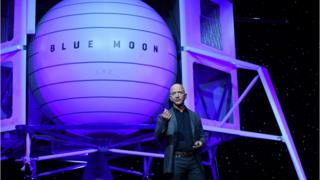Jeff Bezos Unveils Moon Lander Concept
 Image copyright
Reuters
Image copyright
Reuters
Amazon entrepreneur Jeff Bezos has unveiled a mock-up of a new lunar lander spacecraft that aims to take equipment and humans to the Moon by 2024.
The reusable Blue Moon vehicle will carry scientific instruments, satellites and rovers.
It will feature a new rocket engine called BE-7 that can blast 10,000lb (4,535kg) of thrust.
"It's time to go back to the Moon, this time to stay," said Mr Bezos.
Mr Bezos presented the Moon goals of his space exploration company Blue Origin at the Washington Convention Center in Washington DC, to an audience consisting of potential customers and officials from Nasa.
The Blue Moon lunar lander comes loaded with enough fuel to get from Earth to the Moon.
It can deliver payloads to the lunar surface, deploy up to four self-driving rovers, and launch satellites to orbit the Moon.
A pressurised vehicle for humans is also envisaged.
Blue Moon will weigh 33,000lb when loaded with fuel on lift-off from Earth, which will decrease to about 7,000lb when it is about to land on the Moon.
The aim is for Blue Moon to land on the south pole of the Moon, where ice deposits have been found in craters.
The water derived from that ice can be broken down to produce hydrogen, which could then fuel up the spacecraft for further missions across the solar system.
In March, the Trump administration announced that it intended to return US astronauts to the Moon by the end of 2024.
In his speech, Mr Bezos said that Blue Origin would be able to meet Trump's deadline, but "only because" the firm had begun designing the lunar lander in 2016.
Mr Bezos wanted to improve access to the Moon, because he has a wider vision of a future where people are able to live and work in space, which is not possible today.
"The price of admission to do interesting things in space right now is just too high because there's no infrastructure," he said.
To illustrate this, he showed pictures of self-sustaining space colonies that could support people, animals and greenery - somewhat similar to the concepts developed by Princeton physicist Gerard O'Neill.
From Chip War To Cloud War: The Next Frontier In Global Tech Competition
The global chip war, characterized by intense competition among nations and corporations for supremacy in semiconductor ... Read more
The High Stakes Of Tech Regulation: Security Risks And Market Dynamics
The influence of tech giants in the global economy continues to grow, raising crucial questions about how to balance sec... Read more
The Tyranny Of Instagram Interiors: Why It's Time To Break Free From Algorithm-Driven Aesthetics
Instagram has become a dominant force in shaping interior design trends, offering a seemingly endless stream of inspirat... Read more
The Data Crunch In AI: Strategies For Sustainability
Exploring solutions to the imminent exhaustion of internet data for AI training.As the artificial intelligence (AI) indu... Read more
Google Abandons Four-Year Effort To Remove Cookies From Chrome Browser
After four years of dedicated effort, Google has decided to abandon its plan to remove third-party cookies from its Chro... Read more
LinkedIn Embraces AI And Gamification To Drive User Engagement And Revenue
In an effort to tackle slowing revenue growth and enhance user engagement, LinkedIn is turning to artificial intelligenc... Read more

